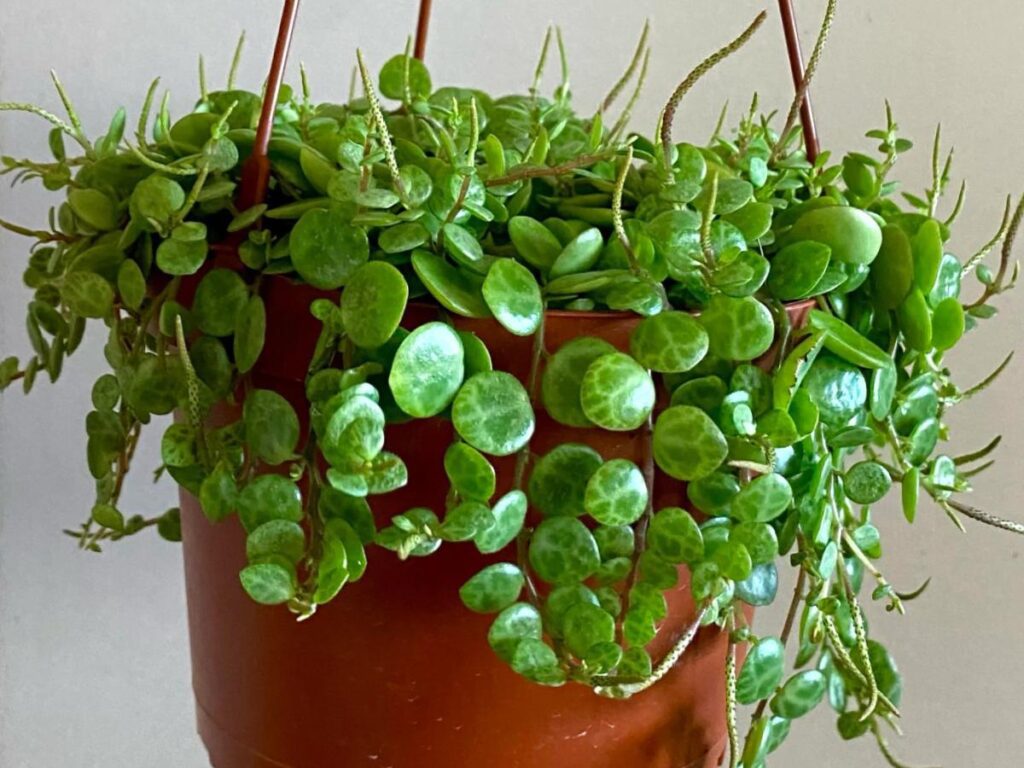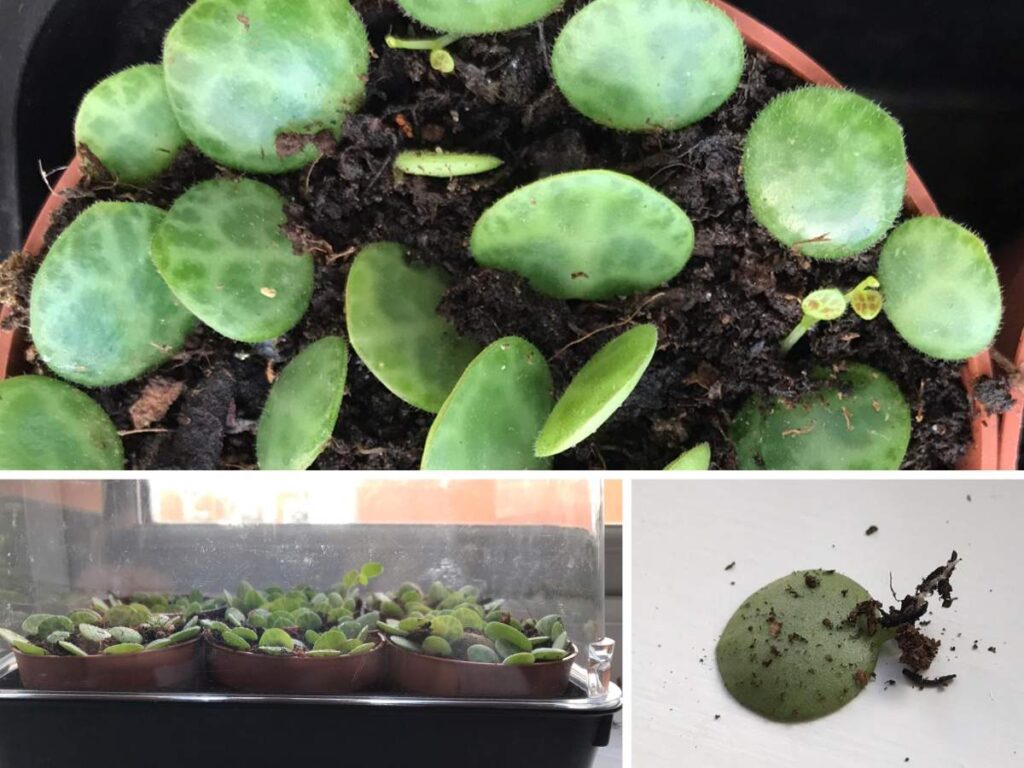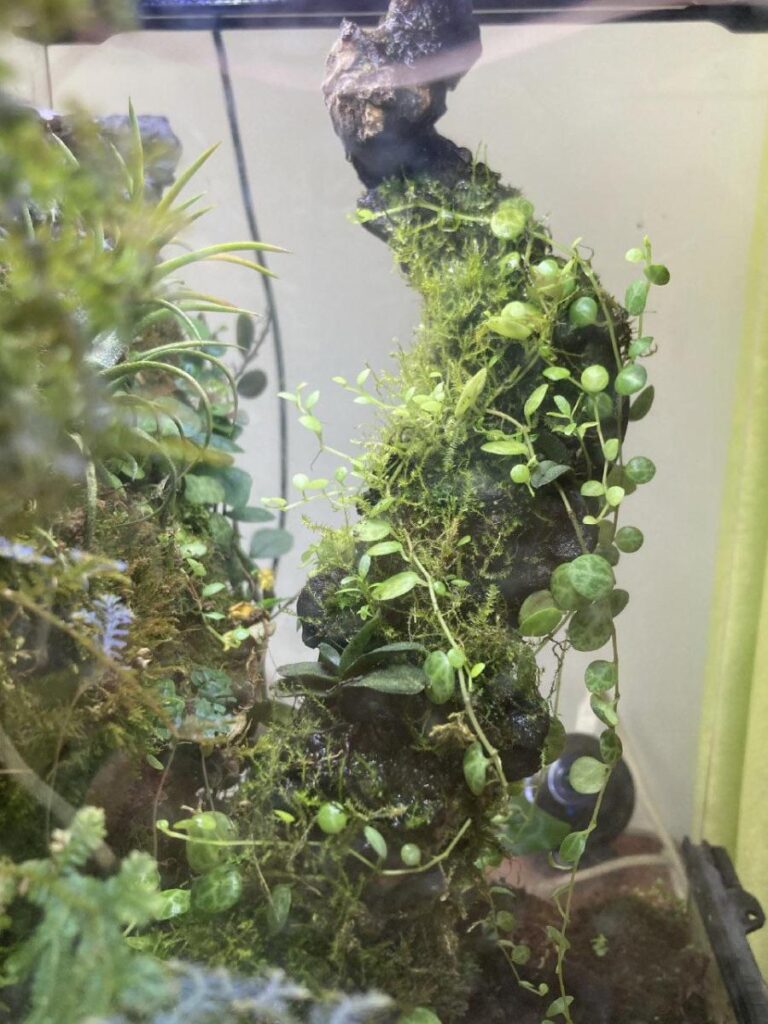Are your string of turtles struggling to thrive? And are you looking for a guide that’s complete, organized, and easy to follow? Then you’ve come to the right place.
In this guide, we will let you know everything you need to know about caring for this beloved houseplant.
Are String of Turtles Easy to Care For?
String of turtles are easy to take care of. They don’t need much care, and they can grow in a wide range of conditions. As long as you provide proper care for your string of turtles, they’ll be happy and healthy no matter where you put them.

How to Care for String of Turtles?
You need to ensure the best conditions for this plant to grow. Some requirements to take care of the string of turtles plant are: providing enough light, water, and fertilizer; arranging the stem in a way that allows good air circulation; and disposing of damaged leaves.
1. Light
The light that provides indirect light to the string of turtles plant helps it grow and thrive. The plants are able to survive under artificial light as long as it is bright and provides indirect light.
They will do best in a northern or southern-facing window that receives a lot of indirect light. East- or west-facing windows work well for growing string of turtles plants, but they will not do as well if kept in direct sunlight all day long.
This tropical houseplant won’t do well if the temperature falls below 50°F. However, it will be just fine at room temperature and can handle higher temperatures too. Make sure to keep your turtle plant above 50°F in order for its growth and health to stay consistent.
The string of turtles will do best in climates that have warm summers and mild winters.
2. Temperature
The string of turtles prefers temperate to warm temperatures. Keep your Peperomia away from drafty areas, such as an air conditioner or central heating vent, and keep the temperature inside the acceptable range.
To keep the string of turtles warm, keep the room they live in around 65–75 degrees Fahrenheit (18–24 degrees Celsius). Avoid extremes, and bring them inside well before freezing temperatures arrive.
To cool them off, bring them into a cool room (around 50–60 degrees Fahrenheit/10–16 degrees Celsius) for a short time.
To keep the temperature in your home in the string of turtles range, you don’t have to do anything special. Temperature requirements for Peperomia prostrata vary, but should be between 65-85 degrees Fahrenheit
3. Water
It’s important to remember that string of turtles plants (Peperomia prostrata) are native to the Brazilian rainforest, so they prefer slightly moist conditions. With that in mind, make sure the pot has drainage holes and can hold water well. Then, let the soil dry out between waterings to avoid overwatering.
Overwatering is the most common cause of leaf loss in turtles. In You should water sparingly in winter since the leaves will store water. Give the plant water equal to 1/5th of its volume in a pot to avoid overwatering.
The string of turtles needs water when the top few inches of soil are dry. Use bottom watering if you have a small pot or if growth has decreased significantly. If the soil is too dry, water it using the bottom-up method.
Do not allow excess moisture to sit on top of soil surface which can lead to root rot
When does a string of turtles need water?
When it comes to watering your string of turtles, you’ll want to take a few things into account.
First, you don’t need to water your string of turtles as often if you live in a place where it is cool and the soil moisture is higher than normal.
Second, you can check the dryness of the soil by simply inserting your finger in it. You should be able to go several inches before your finger feels moist soil. If you’re looking for a more precise and sophisticated way to measure tension, you can use a tensiometer.
Third, water your Peperomia prostrata when the soil is 50% to 75% dry. This equates to watering only once every two or three weeks for many indoor gardeners, but your plant’s needs may vary depending on the amount of humidity in your home and other factors.
What are the signs of overwatering string of turtles?
If you see any of the following symptoms, it’s an indication that you’re overwatering your string of turtles: leaves turning yellow, the string of turtles shriveling, root rot, mushy foliage, and the string of turtles wilting and falling off. So, let the soil dry out between waterings.
You can try to save the plant by letting the soil dry out completely, cutting off any damaged leaves, and then starting to water it again in a more normal way.
4. Humidity
The string of turtles needs humidity because their roots haven’t evolved to grow in soil that is always wet.
Peperomia prostrata likes high humidity and does well in moist moss and leaf litter, but it needs to be carefully watered in a planter.
Keep humidity levels above 40% to prevent root rot. If your home is dry, run a humidifier to keep things comfortable for turtles
Can a string of turtles get wet?
To keep a healthy string of turtles, it is important to water them lightly and never wet them. I would mist them once they start getting big, as the roots will absorb nutrients better than the leaves. If you only mist and don’t water at all, then you’ll need to mist more often as they’ll lose that water faster.
5. Soil and Planting
Write how soil affects string of turtles
String of turtles need well-draining soil with a pH level of 5 to 7. You can combine peat moss or coconut coir with some well-rotted compost or worm castings to make a perfect soil mix for your plants.
Mixing equal parts potting soil and perlite is one approach to increase the soil quality for your turtle string. A soil mixture for a string of turtles should be light and free of gritty materials, like gravel.
Good drainage is key for healthy plants, which can be grown in a normal planter. Succulent plants need gritty soils to survive, so a light soil mixture is perfect for string of turtles.
The string of turtles needs 70% regular houseplant soil, 15% perlite, and 15% fine orchid bark. You can either mix your own soil or use a pre-made succulent medium like succulent cactus potting mix.
What soil does a string of turtles need?
The best soil for this plant is a mix using peat moss, coconut coir, compost, or worm castings. The string of turtles needs good drainage to avoid waterlogging. They like a mix of soil that is a little bit airy but has some grit in it to help water flow easily.
By mixing equal parts of potting soil and perlite, you can make a soil that drains well and keeps water.
How to plant the string of turtles?
There are a few different planting options for string of turtles: you can grow them in a plant terrarium or in a hanging pot. You don’t need to cover the roots with soil when growing a string of turtles in a pot. The most popular choice for growing string of turtles is hanging pot , which allows the long stems to trail down
6. Fertilizing
Fertilizing a string of turtles can help them grow and thrive. To fertilize them, mix a specific feed with water or apply it directly to the soil.
Be careful not to put in too much fertilizer, as this could damage the leaves on the turtles’ bodies.
Apply fertilizers monthly during the growing season and once a month all year.
Always water the soil before applying fertilizer to avoid root burning.
7. Pruning
Pruning a string of turtles helps to control size and growth. Pruning can also encourage new growth in a string of turtles. In addition, prune your string of turtles plants to keep them looking good and free from pests.
Always cut just below a node to get the plant to branch out and make it bushier.
Use sharp, sterilized scissors to avoid injuring the plant.
How do you take care of a turtle’s string cuttings?
When taking care of a turtle’s string cuttings, it is important to follow the same basic rules as when taking care of the plant itself.
To avoid damaging the cuttings, always use sharp, sterilized scissors.
Pinching the stem to stop growth is one way to prune.
If you want new branches to grow from a node, make your cut just below it.
Pruning should be done lightly so as not to reduce growth or damage the plant.
Should you remove the blooms from your string of turtles?
If you see flowers growing on the string of turtles plant above ground, it is best to leave them be. Pruning the flowers can lead to a weaker and less healthy plant. If you are concerned about the health or growth of your string of turtles, always cut just below a node to encourage branching and increase the bushiness of the plant.
8. Dividing or Repotting
Peperomia prostrata is not a plant that commonly needs to be divided or repotted. This is because it is not a quick grower and does not get very large. If it does outgrow its pot or if the soil needs to be refreshed, the best time to do so is in the spring.
To divide or repot a string of turtles, cut the stem where you want it and move the plants to a new pot.
To repot a string of turtles, remove the plants from their pots and divide them among new, larger pots.
If you want to go up in pot sizes, do so gradually.
Repot every three years in the spring.
Do strings of turtles like shallow pots?
The string of turtles often do well when kept in shallow pots, as this allows them to get plenty of sunlight and water. Keeping the turtles in a pot with a deep bottom can make it difficult for them to get enough air and sunshine, which may cause health problems.
Do string of turtles like small pots?
When it comes to potting or re-potting, a small pot is really the best option because the Peperomia prostrata root system is very shallow. It’s also a helpful visual reminder for you to avoid overwatering. You can use any type of potting mix as long as it drains well.
9. Common Pests and Plant Diseases
Pests and diseases that can affect the string of turtles include spider mites, whiteflies, mealybugs, and fungus. To protect your turtle from these problems, keep good plant health in mind by watering regularly and using insecticidal soap on pests.
Maintaining a clean environment will also help reduce pest populations.
Propagating String of Turtles
To propagate a string of turtles, you should cut off healthy growth and then propagate the cuttings. Cut a stem in the spring or summer and lay it in a shallow pot of moist soil, sphagnum moss, or perlite.
Cover the top of the pot with Saran wrap and puncture it to allow air circulation. Remove the Saran wrap approximately once each week to allow the plant to breathe.
You can root a string of turtles by following these steps:
– Mist the soil with fresh water
– Check the propagation of the string of turtles frequently to determine its health.
– Check water and air circulation, and adjust as needed.
– Root the stem cutting after a few weeks Put the stem cutting in water and watch for root growth to propagate a string of turtles.
Planting a new plant in fresh soil when the water roots have converted into soil roots and keeping the plant moist for a few weeks while the water roots are converting into soil roots Follow instructions carefully to ensure success

Is String of Turtles Rare?
The string of turtles is a rare succulent that is often sold in garden centers and nurseries. The string of turtles is unique among other succulent plants because of its turtle-shaped leaves. Not only are they beautiful, but they also make an interesting addition to any landscape.
Because string of turtles plants can take quite some time to grow, once they do, they are considered to be very valuable houseplants. Some specimens even sell for a considerable amount of money.
It may take some time for the turtle strings to reach their full potential, but when they finally do, you definitely won’t want to miss out on it!
Where to Buy String of Turtles Plant?
It’s difficult to find a string of turtles in stores, but they are available online or through a local nursery. You can also find them online at reputable retailers such as Etsy, Amazon, local home improvement stores, and other retailers for an average price of $10 to $30.
They are relatively affordable, making them an affordable addition to any home. The plant feels great to touch and is easy to care for.
Is String of Turtles a Peperomia?
The string of turtles represents the genus Peperomia and the family Piperaceae. It is typically found in the rainforests of Brazil, This plant is very popular for people to have in their homes because it does not require a lot of care and can thrive in many different conditions.
- Common names: String of Turtles, Peperomia Prostrata
- It prefers cool to warm, humid weather and is easy to care for under average room conditions.
- The string of turtles is a beautiful and rare plant that is perfect for a hanging basket.
- They are succulent plants with a vining habit that forms a very beautiful mat.
Is String of Turtles a Succulent?
The string of turtles is a succulent plant. If you’re in the market for a pretty and low-maintenance houseplant that will brighten up any room, try out a string of turtles, otherwise known as Peperomia prostrata. They are easy to grow and can handle a variety of growing conditions.
Plus, they’ll add some much-needed joyfulness to your home!
Does String of Turtles Climb?
The string of turtles is known as a hanging basket plant. But you can train them to climb by using a homemade trellis. They will climb in the direction of the light. They will create impressive images that make you feel like you are in a fairy garden.
Some homemade trellis versions are made with wooden dowels, chopsticks, or dried branches cut to size.

How Long Does a String of Turtles Live?
With proper care, including trimming, watering, fertilizing, and providing appropriate light, the string of turtle plants can live approximately 2–4 years. They require full sun during their first 8–12 weeks until they become more established and can tolerate a few hours of direct sunlight a day.
In addition, propagating a string of turtles will help make this wonderful plant available in your home year after year.
How Long Does a String of Turtles Take to Grow?
A string of turtles typically takes three to five years to mature, and in ideal conditions they can grow up to two feet long. Its maximum width depends on the size of the pot. Usually we expect this plant to grow in width rather than tall.
The key to taking care of this plant is providing a clean environment with plenty of water and a diet that includes fresh vegetables and fruits.
Are String of Turtles Fast Growing?
The string of turtles is a small plant with a slow growth rate, reaching full maturity in three to five years. It grows the fastest when provided with the ideal growing conditions. So this plant is a good choice if you have limited space.
If growth seems to be very slow for your plants, it may be due to one or more of the following reasons: warmth, insufficient light, poor potting mix, or overwatering. If you notice that your plants aren’t growing as much as they should and this has been going on for a while, it’s probably time to look into some of these factors.
How To Make String of Turtles Fuller?
The string of turtles is slow-growing. If your string of turtles are healthy and evenly distributed, all you can do is wait for your plants fuller. You are taking good care of them if you are giving them enough light and water.
Your string of turtles will fill in nicely with time and patience.
Is String of Turtles Toxic to Cats? (or Dogs)
String of turtles is not toxic to cats, but if they eat too much plant matter, they could get stomach problems. It’s best to keep them away from cats and try to keep them out of the plant’s reach. Cats can damage plants by rubbing against the leaves.
String of turtles is not toxic to dogs, but consuming too much foliage may cause them to vomit and have diarrhea.
Common Problems for Peperomia Prostrata
There are a few common problems that can happen to Peperomia prostrata, but most of them can be avoided with good care. Root rot, pests, damaged leaves, overwatering, stunted growth, and distorted or burned leaves are all common issues when caring for a string of turtle plants.
Root rot
Root rot is caused by moist or waterlogged soil, and can cause stunted growth and a rotten brown base.
A lack of leaves on the soil’s surface could be a symptom of root rot.
If you suspect root rot, inspect the health of the roots below the compost line.
Improving growing conditions by watering from the bottom up can help prevent root rot.
If the roots are brown and mushy, you must trim them off with sterile scissors.
To treat root rot, you must remove the plant from the pot, clean off the roots with sterile water, and repot the plant in fresh soil.
Mealybugs
Mealybugs are small, white, winged insects that feed on new growth.
Overfertilization and overly moist soil are the most common causes of mealybug infestations.
Mealybugs can be eradicated with a 10:1 solution of water and isopropyl alcohol.
Spider mites
Spider mites are small, eight-legged pests that suck the sap from the leaves of plants. Signs and symptoms of spider mite infestation include: dull leaves with a dusty appearance, curled or distorted foliage, and rapid growth.
Spider mites can be killed with homemade insecticidal soap, but prevention is better than cure. To avoid problems in the future, spray neem oil as a preventive measure and keep the humidity high.
Whiteflies
The signs of a whitefly infestation include wilted or discolored leaves, and nymphs that are unable to fly. Insecticidal soap and neem oil can be used to remove them, but they may return.
Dull, damaged leaves
Dull, damaged leaves are a common symptom of overwatering. To fix the problem, move the plant out of the sun, cut off any damaged leaves, and only let it sit in the sun for an hour a day.
Why Do String of Turtles Plants Have Dry Ends?
The ends of a string of Peperomia prostrata vines may look dry and shriveled, indicating that the soil is completely dried out. If the soil is completely dried out, you can check it with your finger or lift the pot to see if it’s really light.
You should give your plant a good watering if it has dried out completely.
Why Are String of Turtles Plants Leaves Turning Yellow?
The most common causes of yellow leaves on Peperomia prostrata are sitting in water for too long, growing in a pot too large, or having poorly draining soil.
Solutions to this problem include reducing the amount of time spent sitting in water, growing plants in smaller pots, and improving the soil’s drainage.
Why Are String of Turtles Plants Leaves Turning Brown?
The leaves on a plant can turn brown and crispy if the plant is not watered properly. To prevent this from happening, check your water levels frequently and top them off as needed.
In addition, too much direct sun causes string of turtles’ leaves to turn brown.
Planting mix needs to be evenly moistened for the best results.
Why Are String of Turtles Plants Leaves Reddish in Color?
The leaves of the string of turtles are red in color because they have been exposed to direct sunlight for too long. You can limit sun exposure by only allowing 1 hour of sunlight per day. Remove damaged, red, or yellow leaves to help the plant focus on new growth.
Why Is String of Turtles Plant Dropping Leaves?
The leaves of the string of turtles are dropping due to a lack of water in the soil. To address this issue, check the soil for over or under watering and adjust as needed.
If growth problems are causing drops in leaves, it may be a result of better growing conditions rather than disease or insects.
If the soil has dried out, add water to moisten it back up again. If there is an uneven amount of water in the soil, adding a wetting agent may help bring things back into balance.
Why Do String of Turtles Plants Have Small Leaves?
If the leaves on Peperomia prostrata are small, this may be due to inadequate light. Increasing the amount of light available to the plant will help it grow faster and produce healthier leaves.
Why Is My String of Turtles Leaves Turning Black?
If the leaves of your string of turtles are turning black, it might be because there’s too much direct sunlight.
If the variegation on the leaves is disappearing, it might be because of a lack of bright light.
If the soil is dry and the tips or leaves are dropping, it might mean that there isn’t enough water in the pot.
Avoid getting the leaves wet to prevent this from happening.
String of Turtles FAQs
What Is String of turtles Plant? (Peperomia Prostrata)
A string of turtles is a succulent that can reach up to a foot in length and has the capacity to store water. The succulent typically blooms with rat tail-like flowers, has a leaf pattern that is reminiscent of a turtle shell, and is commonly known as Peperomia prostrata.
Where Is the Best Place to Put String of Turtles?
You should place a string of turtles in front of a window that gets indirect light, but avoid all day sunlight. In addition, you can provide your plants with 2-3 hours of direct sun every day. This will give your plant the best chance to grow and thrive.
What Is the Best Way to Mist String of Turtles?
Use a spray bottle filled with room-temperature water to mist a string of turtles. Be sure to keep the water level low enough so that it doesn’t drip onto the turtle but high enough that it feels wet. You can also use a gentle stream from a hose.
What Type of Fertilizer for String of Turtles?
When it comes to fertilizing your houseplants, you should use a traditional fertilizer like houseplant fertilizer diluted in a 50/50 mixture. This will help make sure that your plants are receiving the correct amount of nutrients and exposure to sunlight.
To keep a string of turtles healthy, feed them with a fertilizer mix twice a month during the spring and summer.
You can also feed them with diluted liquid fertilizers biweekly during the growing season.
You should avoid fertilizing your plants in the fall or winter.
How Do You Repot a String of Turtles?
To repot a string of turtles, you will need to:
-Remove the string of turtles from the old pot
-Gently shake off any dirt or soil that may be clinging onto the roots of your plants.
-Inspect the roots for any brown or mushy roots and trim them if necessary
-Allow the roots to dry if they are moistened
-Place the string of turtles in their new pot and cover with soil
-Water your plant
How Do You Store a String of Turtles?
To store string of turtles, you need to submerge their pots in water and a soil mix.
You can grow string of turtles from seeds, but make sure you get them from a reputable retailer.
To increase the chances of success, sow the seeds in a sterile environment and use a new well-draining potting mix.
To store turtles, cover them loosely with soil, keep them warm and moist, and avoid direct sunlight.
It may take up to a month for the turtles to germinate. If they do not germinate within two months, they have most likely died.
Are String of Turtles Fragile?
The string of turtles is thin and fragile, so be careful not to overwater them. Proper drainage is essential for keeping them healthy, and adding perlite to the soil will improve aeration. The string of turtles prefer soil with a pH of 5-7, which is acidic to neutral.
Final Thoughts
If you have string of turtles, it’s important to take care of them properly.
This guide will show you how to water and fertilize them, prevent pests and diseases, and provide tips for keeping your turtle population healthy.
By following these simple steps, you can help keep your string of turtles thriving!









